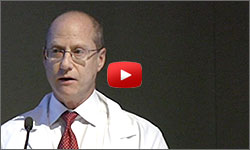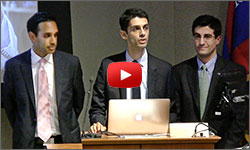News
Nine Ways Staff Clinicians Would Change Penn Medicine
Report With Video From The Fourth Annual Health Care Innovation Center "Pitch Day"

Seven of the nine “Innovation Accelerator” projects presented at the fourth annual Penn Medicine Center for Health Care Innovation “Pitch Day” forum explored creative “connected health” or “automated hovering” ideas. Both concepts refer to the use of new digital technologies to connect and centrally coordinate currently disparate clinical information and biometric monitoring systems that are critical to managing patient care.
The teams of physicians and nurses offered proposals on a range of potential innovations from a new sort of digital monitoring system to address nutritional deficiencies among ICU patients, to innovative ways to reorganize the ER’s approach to hyperglycemic emergencies or the reduction of hospital readmissions for liver transplant patients.
Inventing the process of innovation
These efforts are all health services research projects focused not only on specific ways to reduce costs or improve care outcomes but also on the process of innovation itself carried out in the enormously complex environment of a major teaching hospital.
While the Pitch Day program began as a simple contest four years ago, it has rapidly evolved into a significant component of Penn Health System’s strategic planning fostered by both the spirit of the Affordable Care Act and the broader demands of regulators, payors and patient advocates for lower costs and higher quality in health care.
Held in the University of Pennsylvania’s Jordan Medical Education Center, the event drew a large audience including the Penn Medicine CEO, Perelman Medical School Chief Administration Officer, the dean of Nursing school, and a number of department heads.
“While Pitch Day marks the end of 6 months of disciplined focus on critical problems in health care delivery, it also marks the beginning of moving solutions into our day to day workflows,” said Innovation Center Executive Director David Asch. “In the end, this program succeeds not just because it helps achieve solutions to pressing problems that matter to patients, but also because it showcases and enables the passion and energy of the people at Penn Medicine essential to constantly advance the care of those patients.”
Front line physicians
What makes the Innovation Center’s “Innovation Accelerator” program different is that it has mobilized Penn Medicine’s own front line physicians, nurses and technical professionals to identify the opportunities within their own spheres of daily care activities. And it has then provided them with the funding and support needed to conduct pilot innovation projects exploring their own ideas of how to achieve these opportunities.
The innovation teams work according to product development concepts pioneered in the software industry. They conduct short-term, fast-turn-around experiments that provide insights into the probable viability of a given idea for logistical, communications or management change. Promising results incrementally move the work to a new phase of broader testing. At the end of six months, the teams report their findings in the “Pitch Day” event.
According to Penn Medicine Chief Innovation Officer Roy Rosin, nine team ideas were selected from more than 90 submissions. Seed funding for the research was provided by United Healthcare.
Targeting ‘sacred cows’
“These were particularly important projects,” said Rosin, an LDI Senior Fellow and former software industry innovation executive. “Some focused on patient populations that have the highest readmission rates, others went after ‘sacred cows’ and some long held beliefs that may need to change. All of this year’s projects required entirely new thinking.”
In remarks that closed the event, Penn Medicine CEO and LDI Senior Fellow Ralph Muller, who has previously written about the topic in the New England Journal of Medicine, emphasized the importance of automated hovering technologies, particularly those linked to mobile phones.
For example, Vandana Khungar, MD, MSc, demonstrated how switching a monitoring strategy to a mobile phone-anchored system decreased watching over patients with advanced liver disease from $1,000 to $50.
“Tying all these processes to a mobile phone is the way to go because today we all have phones and are looking at them all day long,” Muller said, holding up his own iPhone. “We have to keep asking ‘how do we make this part of the way in which we live as both care givers and patients?”
Muller continued his remarks by speaking with pride and promise of all the Pitch Day participants.
‘Teamwork and incredible energy’
“One of the things we like to talk about inside the hallways of Penn Medicine is how much we are collaborators,” he said. “Today, we could really see that in the teamwork and incredible energy that each of these presentations displayed.”
Making their pitches were five winning teams and four finalists. Here are the videos of individual team presentations in the order in which they were delivered:
PRESENTATION VIDEOS
Optimized IDTS
Keith Hamilton, MD, Director, Antimicrobial, Infectious Diseases
Thousands of patients annually contract infections severe enough to require lengthy courses of intravenous antibiotics. Most are discharged and required to infuse themselves at home for weeks. The complexity of this process is evident in the 29% of those OPAT (Outpatient Parenteral Antimicrobial Therapy) patients who are readmitted within 30 days. This team created a digitally empowered Infectious Diseases Transition Service (IDTS) that enabled clinicians to provide new kinds of daily support to OPAT patients that reduced readmissions to 16%.
Calorimeter – Monitoring ICU Nutrition
David Do, MD, Neurology Resident
Nutritional deficiency is a widespread problem in ICUs. This team found that only 38% of patients receive enough calories and only 11% receive enough protein each day. It also found that doctors and nurses have very little awareness of how well their ICU patients being fed and that there is no single person charged with monitoring patients’ actual caloric intake. The team developed a “Calorimeter” alert and intervention system that has resulted in 57% of patients getting sufficient calories and 31% getting adequate protein intake each day.
ICU Care Coordination Platform
Barry Fuchs, MD, Medical Director,
ICU and Respiratory Care Services
ICUs are charged with caring for the sickest patients in a hospital and do so with an enormously complicated array of technologies, pharmaceuticals, and data streams. They are also somewhat chaotic work environments because of the steady cacophony of audible alarms from monitors and IV pumps that can distract clinicians, causing routine ICU tasks to be delayed or missed. This team created a centralized digital system that screens all unit data round-the-clock and sends text messages to clinicians alerting them to actions that might have otherwise been delayed or missed.
Palliative Integrative Care Kit
Susan Kristiniak, DHA, MSN, Associate Director,
Palliative Care
Although not recognized by the NIH as part of conventional medicine, “integrative therapies” like aroma therapy, guided imagery, yoga, and acupuncture are known to ease anxiety and pain among palliative care patients. In that same spirit, this team created a “delight” product that can be given to patients and their loved ones to lessen stress at a profoundly sad time. The “Penn Delight” box contains personal aroma dispensers, lavender lotion and ear buds for listening to guided imagery — a form of meditation driven by audio recordings of soothing music and tranquil narrative.
Motivating More Patient Mobility
Jennifer Nelson, RN, MSN, Nurse Manager
Staci Pietrafesa, RN, MSN, Nurse Manager
A gentle but persistent battle nurses wage in post-surgical wards is motivating patients to regularly get up and walk around. Lower levels of physical activity are associated with increased length of stay, increased complications, mortality and readmissions. This team, headed by two nurse managers of post-surgical units, turned their ward environments into a “Mobility” game with differently distanced “regions” like “Tropical,” “Sahara, and “Safari.” The end result was that 88% of patients in the game group met goals for mobility and timely discharge compared to only 40% of the control group.
Clinical Trials Management Platform
Nathan Handley, MD, Fellow,
Division of Hematology/Oncology
For specialists in private practice as well as hospital departments, matching patients to appropriate clinical trials is a complicated process made even more so by the lack of a comprehensive central system for collecting and tracking the details of a medical center’s ongoing trials. After repeatedly hearing colleagues note that ‘I work here and I don’t even know what clinical trials are available,’ oncology Fellow Nathan Handley created the prototype PennTrials.org, a point-of-care tool for keeping constantly updated track of oncology-related clinical trials at Penn.
Communication with Subspecialty Consultants
Srinath Adusumalli, MD
Paul Fiorilli, MD
Sameed Khatana, MD
Fellows, Cardiovascular Medicine
A frustration for ED providers is the daily and often arduous task of trying to locate and communicate with one or more specialist consultants whose input is required before a given patient can be discharged. The process can take hours and occurs several times a day, according to this team of three cardiology fellows. To solve this, they’ve created a chatbot system that can spider across the incompatible tangle of internal communications and scheduling systems to locate that specialist and route a text message back to the ED with a direct phone number.
Target Path for Hyperglycemic Emergencies
Nikhil Mull, MD, Co-Director, Evidence-Based Practice
Ilona Lorincz, MD, Director of Quality,
Endocrinology
This project was a team effort to implement evidence-based guidelines for the treatment of Diabetic Ketoacidosis (DKA), the most severe complication of Type 1 diabetes. Analysis of the current ED treatment pathway for DKA showed there were seven different guidelines in use and no consensus about appropriate treatment. Long-held conventions dictated ICU care despite studies that found to the contrary. The team established a new evidence-based guideline, created a dashboard control system that identifies eligible patients and text messaged ED providers with reminders of the new guidelines.
Better Living: Reducing Hepatology Readmissions
Vandana Khungar, MD, MSc,
Associate Professor of Medicine
The hepatology challenge this team took on was this: about 30% of cirrhosis patients and liver transplant patients are annually readmitted to the hospital within 30 days and at an additional cost of more than $21 million. Their hypothesis was that weight, mental function, medication adherence and temperature are effective measurements of readmission risk and the goal was to use digital automated hovering techniques to monitor those metrics daily. The result, using mobile phones connected to the “Way to Health” interactive research platform, reduced 30 day readmissions to 13%.








